Raytheon and the US Navy say they have completed a new round of successful Excalibur N5 munition test firings.
The precision-guided projectiles demonstrated various short-, mid- and long-range capabilities, say the defence firm in a release.
Designed to be fired from the US Navy’s five-inch guns, Excalibur N5 is the sea-based variant of the extended-range munition used by ground forces. Raytheon say that the Excalibur weapon provides accurate, first-round effects at all ranges in all weather conditions and that is something recent tests have aimed to prove.
“Excalibur N5 answers the Navy’s need for a sea-launched, precision-guided projectile,” said Sam Deneke, Raytheon Land Warfare Systems vice president.
“N5 doubles the range of the Navy’s big guns and delivers the same accuracy as the land-based version.”
Excalibur has been fired more than 1,400 times in combat. The precision-guided projectile was co-developed by Raytheon Company and BAE Systems Bofors.
Besides N5, Raytheon has developed other variants such as the laser-guided Excalibur S, Excalibur HTK and Excalibur Shaped Charged Trajectory.
Last year, BAE Systems and Leonardo also announced new precision-guided ammunition that could see the effective firing range of the Mk 45 naval gun tripled, the same gun that will be fitted to the Type 26 Frigate.
Last year, BAE received a $245 million contract from the Ministry of Defence to provide the gun system, known as the Maritime Indirect Fires System (MIFS), for the Type 26 Global Combat Ship. Under the contract, the company will manufacture three MIFS Integrated Gunnery Systems (IGS) and one trainer system for the UK Royal Navy. The MIFS IGS includes the 5-inch, 62-caliber Mk 45 Mod 4 Naval Gun System, along with an automated ammunition handling system, gun fire control system, and qualified ammunition.
Joe Senftle, vice president and general manager of Weapon Systems at BAE Systems said:
“As a leading global provider and integrator of all major caliber weapon systems, we are expertly positioned to integrate mission-driven, advanced, and affordable munitions like Vulcano into land and naval gun systems.”
Gianpiero Lorandi, managing director at Leonardo Defence Systems said:
“The Vulcano long-range guided ammunition family — part of the Leonardo’s global offer of naval, land-based, and aeronautical weapon systems for customers worldwide — represents state-of-the-art technology with its unmatched range, accuracy, and effectiveness, which was successfully demonstrated in testing. Not only is it compatible with 155-mm land and 5-inch naval gun systems, Vulcano can also be easily integrated into current and future platforms such as the AGS — a major benefit.”
John Perri, business development director for advanced weapons at BAE Systems was quoted in DefenseNews:
“With this product, we can achieve a maximum range approaching three times the range of standard ballistic ammunition from the Mk 45 gun, which is in use with the US Navy and 11 other navies around the world.”
BAE say that the Mk 45 Mod 4 currently has a range of more than 20 nautical miles (36 km).
“Starting with DDG 81, Mk 45 Mod 4 is being forward-fit to US Navy DDG 51 Class destroyers. Other Mod 4 applications include installations for the fleets of South Korea, Japan and Denmark.”
Deliveries of the gun to the UK are expected to begin in 2020.
Joe Senftle, Vice President and General Manager of Weapon Systems at BAE Systems, said last year:
“Our teams in the US and UK will bring unrivalled skills and expertise to the MIFS development and production. The world-leading Mk 45 will provide the Royal Navy with a proven, reliable, and highly-effective system that is adaptable to firing a wide range of today’s ammunition, as well as future, precision-guided munitions currently in development.”
The Mk 45 is in service with the US Navy and 10 other allied nations. More than 240 Mk 45 guns have been delivered into service globally.




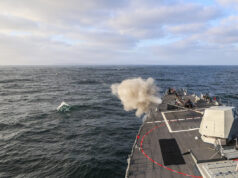
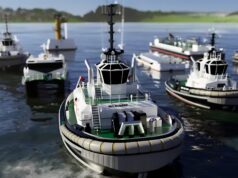
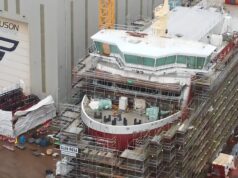
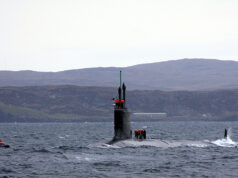
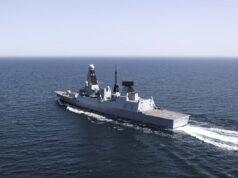

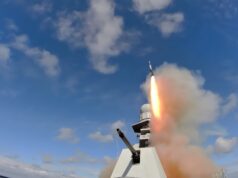
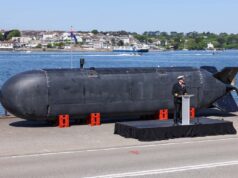
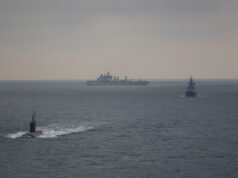

This is must have system.
It would be great if this system with the Mk45 gun was also specified for the T31s. If not now, then in the future as an upgrade.
What is the cost of this ammunition and guidance system? Does it complement or compete with NSM for over the horizon engagements?
It’s inertial guidance and cost around £100K a round
Thx. So a missile would be a better choice for a moving target?
There’s two train of thoughts with these guided rounds. One is that a missile like the NSM gives more options, whilst the thoughts behind the guided 5″ shell/round is that there are more rounds available so more targets can be attacked for the equivalent cost.
Compared to a Martlet, Sea Venom, or NSM these rounds are an order of magnitude cheaper but are getting much closer on circular error probability of where the round lands compared to the accuracy of the missiles. Singularly, they do not have the same explosive content. However, when you are using simultaneous timed impacts, its affects can be made more intense. The 5″ Excaliber N5 round weighs 38.4Kg including guidance system and shell casing the explosive content maybe about 2/3 the weight, so the explosive content could be 25.6Kg. So if we compare it against the explosive content of the NSM = 125Kg, Sea Venom = 30Kg and Martlet = 3Kg, it compares favourably with the Sea Venom.
Using five rounds in a simultaneous timed impact method would give an equivalent to a NSM attack. The only issue is range, to gain more range the rounds require either rocket assistance or use base bleed techniques. The new high velocity round uses a Sabot technique to give it over Mach 3 performance, however in doing so the actual round’s mass is reduced, so there’s less explosive content.
Therefore, these rounds should not be seen as something that takes over from missiles, but as another arrow to your quiver giving you more options on how to engage a target.
Thx. Very informative. So the missiles with their seekers and mid course correction would be better in a cluttered environment?
Depends on which Excaliber or Vulcano round is used. If they just have the combined GPS/Inertial Measuring Unit then they won’t be able to hit a moving target. If they have the semi-active homing laser seeker fitted they could with a 3rd party designator hit a moving target, this has been proven in trials.
Both options missile or a guided artillery round can be used to hit a target in a cluttered location. However, I suppose it also depends on the topology of the targets, like can it only be attacked by using a top attack method.
The Excaliber round can be used for lofted high arcing attacks. I am not sure if the NSM can, the manufacturers blurb does state it can be targeted at specific points of a target, it didn’t say anything about how it does that.
Better then THIS little problem with the Zumwalts. Especially after the mission change. I’ve read the USN will probably strip them of guns and load them with the new low yield nuclear warhead cruise missiles…
https://www.military.com/dodbuzz/2018/01/12/navys-stealthy-mega-destroyer-still-doesnt-have-round-its-gun.html
Cheers.
Thx. Every day is a school day!
Simultaneous Time on target is not easy with a naval gun. With an Army howitzer that has variable zone propellant charges its a lot easier. You can vary charge size with elevation to achieve the effect of having a burst of rounds all land at the same time.
Naval ammo tends to be of the fixed propellant charge type that cannot be varied so you tend to be stuck with a basic ballistic solution that has gun elevation determines range.
The fact that a 4.5/5 inch Naval gun will do something like 20 rounds a minute means STOT is not as important. You can do a burst of 5 rounds and by the time the first one lands the target will only have seconds to recover from the shock before the rest of them arrive.
As DaveyB says with a fixed charge you will need base bleed or rocket assist to improve range.
BB and RA have disadvantages as they give you a greater time of flight . This will add errors into the accuracy of an engagement. Wind shear at various altitudes during the shells flight, temp variation, humidity all add errors in accuracy. By having a smart projectile it allows you to mitigate these variables and allows you to have a good chance of hitting what you are aiming at…even at 50+km
So target range 0-20 miles 5in with cheap ammo; 20-60 miles 5in with expensive ammo; 60-100 miles NSM?
If only some far sighted admiral had decide to select 5 inch guns before the year 2026, its slightly understandable that the T23 has a 4.5 inch gun but it’s inexcusable on T45. More evidence of the skills of the Low caliber public school boys running the military. Much the same short sighted approach has left the 120mm rifled gun on C2.
Bare in mind we were standardising ammunition with the US and NATO allies in the 1940’s. Some how everyone ended up standardised but us.
Why put something like this on the T45 now? In the near future they will be dedicated carrier and amphib group escorts, fulfilling their primary air defence role. Save the money and spend it putting 5″ guns on the T26 and T35 that might be more likely to use such a weapon.
Come the glorious revolution when I’m in charge of all things defence despite no previous experience or qualifications, I will place a Sea Ceptor launcher behind the main SAM launcher on the T45’s and turn them into pure anti-air ships with a much increased short and long range missile load.
Luckily, the revolution appears to be on hold for the time being…
There where moves afoot to have a 155 on a T45. BAe had done a lot of work in designing and proving it could be done. In the end the practicalities of having to hump 155 shells and the propellant charges around( They would have been fixed in a brass case and not modular or bags as in ARMY guns) in a sea way proved to be one of the reasons along with cost as to why it was binned.
Dont knock it though, the 4.5 is a bloody good gun. In the MOD 1 version its reliable and still very accurate. The base bleed round that was introduced in the mid 2000s has increased the engagement range of the system whilst maintaining the accuracy.
Its still capable of putting 3 rounds into the same 100 square meter area at 18 miles range.
My forte isn’t artillery, just know where to give the co-ordinates. Wasn’t the 4.5″ derived from an anti-aircraft gun? I know Germany tried using a Pzr2000 turret, but it was less than successful. I think it kept jamming due to the ship’s movement.
Has there ever been a successful automatic naval gun that used two part ammo?
It was derived from the abbot self proppeled gun used by the army.
The 5 inch uses 2 part ammo. But the propellant is in a brass case. The loading cycle is a little more complex than say a 4.5 that uses single price ammo.